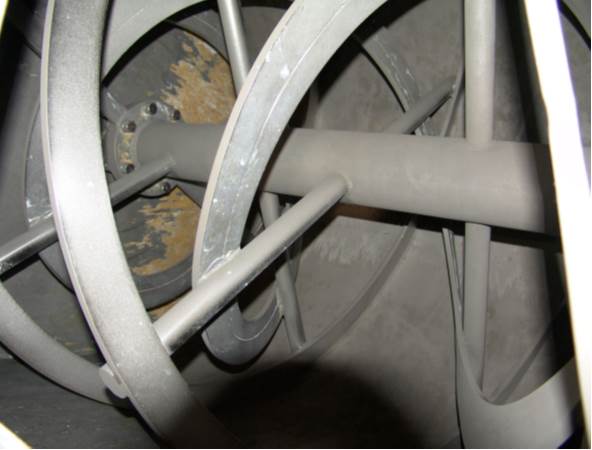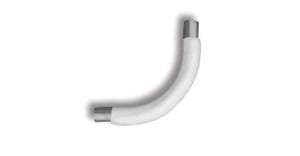February 21, 2014

Mixing is a critical unit operation in pharmaceutical, food, ceramic, cosmetic, chemical, and other industries. There are dozens of blenders and many vendors that all claim they can mix powder materials. However, which of all the blenders is the best choice for your material?
Blending powders requires blender action and geometry induced velocity profiles that cause all the particles to be active in the blending process (no stagnant zones). Each blender style causes a unique set of blending velocity profiles, some of which rely on induced velocities from mechanical interactions such as paddle, ribbon, or screw movement. Other velocities are the natural result of bulk material motion in containers: flow down piles, flow in hoppers, or particles carried by air currents. In either case, blending velocity profiles in mixers must generate differences in residence time paths at various locations in the blender or residence times measured at the blender exit as material passes through. Mixing cannot occur if uniform plug flow exists in the blender; blending requires non-uniform flow. Each blender can be characterized observing the type of motion during blending.
Sometimes blending velocity profiles cause segregation in a blender. Proper blender selection depends on the segregation mechanism occurring during operation. There are many reasons why material mixtures separate (de-mix) during processing and handling. Here we consider the three most common: angle of repose, sifting, and air entrainment. Each mechanism is enhanced or mitigated by different types of blender-induced velocity profiles. Blending mixes the bulk solid; segregation separates key components. Since blending and segregation are opposite effects, the ideal blender would attain blending velocities which do not also cause segregation. Optimal blender choice depends on which action wins: blending or segregation.
To select the optimal blender we must understand the type of segregation inherent with the material, rank the material relative to these active segregation mechanisms, determine what velocity profiles exist in common blenders and finally rank the blenders relative to their potential to segregate due to these velocity profiles. Consider the segregation mechanisms that may be acting with your material.
Angle of Repose
Consider the case where two or more components have different inter-particle friction characteristics caused by differences in particle shape (spheres and angular materials) or by surface roughness effects. In either case, particles sliding down a pile travel at different velocities, causing one type of particle to separate from the other particle as piles are formed and reformed. Generally, angle of repose segregation produces radial patterns as material piles in process equipment. Material with the steeper repose angle accumulates near the pile charge point while the flattest repose angle material concentrate toward the pile edge. Some blenders mix by continually forming and reforming piles. If a blender forms piles during operation with a material sensitive to angle of repose segregation, it separates the particles during blending. Thus, a blender that operates through repeated pile formation is a bad choice with this type of material.
Sifting
In multiple component mixtures, fines may sift through a matrix of coarse particles during handling. Sifting segregation requires that void space between adjacent particles must be large enough to permit fine particles to pass through (a particle size difference of about 3:1). Inter-particle motion exposes empty void spaces to fine particles, and fines must be sufficiently free flowing to prevent arching between adjacent particles. Generally, sifting segregation also produces a radial pattern as material piles in process equipment. Fines accumulate near the pile charge point, decreasing in concentration toward the pile edge. Note that sifting is separation is induced in the direction of gravity. A blender that wishes to undo this segregation effect must induce velocity profiles against the direction of gravity.
Air Entrainment
In many systems, fine particles are carried by air currents and deposited in bins wherever air currents reduce sufficiently for fine particles to drop out of the flow stream. When the falling stream impacts the material level, entrained air is pushed out of the interstitial pores, carrying the fine particles in the resulting dust cloud. This segregation typically causes a radial pattern during pile formation, but fines are at the bottom of the pile and not the top. Mitigating this behavior requires a blending action against the direction of pile formation or operation in such a way as to limit air currents. Since air currents separate the particles, a blender that operates through repeated pile formation without free-fall may be a good choice with this type of material.
Example
Let’s consider three blender types and rank each in terms of its ability to blend via inter-particle motion counter to the direction of gravity, formation of piles during operation, and formation of air currents during operation. We will consider a rotary shell blender (v-blender), a ribbon blender, and a Forberg-style double paddle blender. V-blenders work by placing material into one or both legs of the V-blender until the blender is about half full and rotating the blender. Material in the blender undergoes ridged body rotation without inter-particle motion until the material reaches the top of the pile formed during rotation. Material cascades down the slope, inducing inter-particle motion in a narrow band on top of the pile. All mixing occurs along the pile top. Piles are formed and reformed during operation.
Ribbon blenders work by placing components in a u-trough with left-handed and right-handed dual ribbon screw flights connected to a common shaft. Blending occurs because the ribbons move material in the axial direction. However, during this process screw flights also lift material up on one side of the u-through, forming a pile. In ribbon blenders, mixing due to screw motion is nearly equal to blending that occurs as material cascades down the pile.
Dual paddle blenders work by attaching paddles to counter-rotating shafts. Paddles are angled relative to the shaft so that one paddle lifts the material up and to the right while the next paddle lifts the material up and to the left. These paddles rotate quickly making pile formation minimal. It should be pointed out that, although there is significant inter-particle motion in this blender, that motion is in the upward direction.
We must determine if the blender of interest can induce velocity profiles that result in inter-particle motion, pile formation or gas velocities.
All blenders must induce inter-particle motion. However, some inter-particle motion separates particles and some motions blend mixtures. The worst-case scenario would be a blending velocity 90 degrees from the direction of gravity. Material would sift across the flow direction, percolate through the void structure, and remain in the stagnant layer below. This would cause particle separation without any possibility of remixing the material. If the direction of flow is aligned with gravity, then the velocity profiles can overcome sifting segregation. We can compute a sifting segregation ranking if the angle of flow relative to the horizontal (flow) is known. When a pile exists in the blender, sifting segregation velocity relative to the direction of gravity is given by the pile repose angle.
See Equation 1 (attached)
If the repose angle is 45 degrees, the rank computed from equation 1 is 3.6. In a ribbon mixer, half the material mixes by cascading down the pile and half mixes by transportation along the axial length of the screw. Transporting along the screw results in inter-particle motion, but no slope, so the rank for sifting due to a condition where inter-particle motion but little slope occurs, results in a sifting rank of 1.0. The average rank for sifting in a ribbon blender is the average of the 45 degree and zero slope piles, or 2.3. The rank for sifting in a paddle mixer involves the deviation off the gravitational direction in which the paddle throws material. In this case, the paddle action on the material goes against the sifting direction. We estimated the average trajectory angle due to paddle action is about 80 degrees, yielding a sifting ranking of 8.4.
The angle of repose ranking depends on how close the dynamic angle of the slope in the mixing equipment (r) is to the actual static angle of repose (Sr). We use the ratio in equation 2 as a means of scaling between expected angle of repose effects. This equation relates acceleration between the dynamic and static friction conditions caused by material sliding down piles. The derivation of this equation will not be included here. There is always a difference between the dynamic and static repose angle. For the purposes of this paper we assume that difference is about 5 degrees. Thus, the expected ranking down the pile in both the rotary shell blender and ribbon blender gives a rank of 3.4. However, in the ribbon blender, half the material travels down the pile while the other half is carried by screws with a repose angle of 0 degrees, resulting in a rank of 10 for that part of the material that is conveyed. The overall rank for the ribbon blender is the average of these values, or 6.7. We will assume the average repose angle in the paddle mixer during operation is 6 degrees. This leads to a ranking of 9.9 for angle of repose segregation in a typical paddle mixer.
See Equation 2 (attached)
The ranking for air entrainment are somewhat subjective and depend on operation speed. Rather than use simple correlations to approximate, these ranking are based the author’s extensive experience with various blenders and materials sensitive to air entrainment segregation. All rankings are summarized in Table I. If a material is sensitive to a particular mechanism, this table indicates how easily the blend will mix in the chosen blender.
See Table 1 (attached)
To achieve proper fine powder material blend, one must eliminate segregation issues. Selection of the proper blender depends on the segregation mechanism(s) occurring in the material during blender operation: one must match blender choice to the material properties. Blender selection is often considered an art rather than a science. However, knowledge of basic material flow properties and segregation tendencies provides guidance in selecting the right blender for the task.
Obviously we need a measure of segregation based on mechanism. Ideally we would like to determine the fraction of each mechanism that might be active with the particular material. Measuring segregation can be done by forming a pile, measuring the concentration of key components along the pile and using this data with particle size and angle of repose information of each component to identify the active mechanisms Figure 1. This was done for a steak seasoning mixture (Figure 2).
See Figure 1 (attached)
See Figure 2 (attached)
The data suggest that 65% of segregation occurring with this material is due to angle of repose, 35% is due to sifting, and 0% is due to air entrainment segregation. The question remains: which blender should be used to mix this particular material? Overall rankings for each blender can be found by summing the fraction of each mechanism (frmech) times the rank number (Rankmech) for each mechanism for the blenders of interest (equation 3). For the steak seasoning, blender ranks are found in Table II. Apparently, a paddle blender would be the best choice for this material, followed by a ribbon blender.
See Equation 3 (attached)
See Table 2 (attached)
Conclusions
Blending brings distinct bulk material particles into intimate contact so as to produce a mixture of consistent quality at a prescribed scale of scrutiny. Each blender mixes by a particular set of actions (i.e. pile formation, paddle movement). Segregation undoes blending by inducing separation of distinct particles. If material segregates due to a particular blending action, then any blender causing that action is a poor choice for that material mixture. Thus, we rank blending effectiveness based on segregation mechanism(s) which may occur with the mixture. When we measure the segregation mechanisms and determine the fraction of each active mechanism, we can deduce an overall blender ranking and select the optimal blender based on science instead of trial and error.
Dr. Kerry Johanson began his career and spent 14 years with JR Johanson Inc. in San Luis Obispo, CA, eventually serving as chief technical officer. He received his Ph.D. in chemical engineering from Brigham Young University in 1994, and moved to Florida in 2000, where he divides his time researching at the University of Florida Particle Engineering Research Center and serving as the chief operations officer for Material Flow Solutions Inc., the consulting firm he founded in 2001. He has authored 40+ technical papers that have been published in numerous technical journals internationally. He has developed a course for teaching powder flow and technology to graduate students and mentored five doctoral graduates at the University of Florida.
For related equipment reviews, articles, and news, visit our Mixers & Blenders Equipment Zone
Click here for information about International Powder & Bulk Solids Conference & Exhibition
You May Also Like


